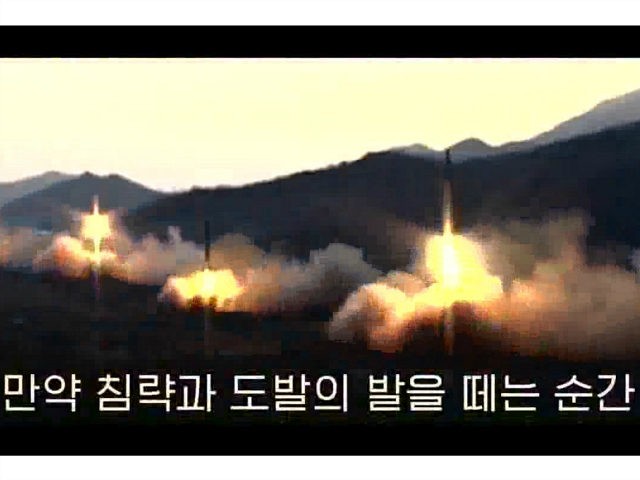A North Korean website has published a propaganda video that shows an American aircraft carrier and Washington D.C. targeted with crosshairs and then exploding in balls of fire.
“The enemy to be destroyed is in our sights… We will show you what a strong country that leads the world in nuclear and missile technology is capable of,” the video caption declares.
The video also contains footage of North Korean parades and military exercises, artillery barrages, and missile launches. The final moments of the clip are a simulated nuclear ICBM attack on Washington.
North Korea is not yet believed to possess the missile technology to attack the U.S. mainland, but this week Admiral Harry Harris of the U.S. Pacific Command told the House Armed Services Committee that more missile interceptors are urgently needed in Hawaii, while Hawaiian lawmakers worked up emergency plans for a possible North Korean attack.
“The crisis on the Korean peninsula is real – the worst I’ve seen,” said Harris.
Meanwhile, the citizens of Japan received the depressing news that their government could promise only a 10-minute warning in the event of a North Korean missile attack. An enormous surge in traffic at Japan’s civil-defense website has been noted this month.
The exploding aircraft carrier is most likely meant as a threat against the USS Carl Vinson, which has finally arrived within strike range of North Korea after some confusion about how long it would take to get there.
This does not seem to be the same propaganda film screened in Pyongyang on the anniversary of North Korean founder Kim Il-sung’s birth. The tone of that film was similar, but it reportedly ended with the nuclear destruction of a city on the U.S. West Coast and an American cemetery engulfed in flames.
South Korean media reports the video was posted on the North Korean website Meari on Thursday, the day after the entire U.S. Senate traveled to the White House for a special briefing on the North Korean situation.
Despite these unnerving signs of escalating hostility, Mark Landler at the New York Times argued on Wednesday that “the drumbeats don’t add up to imminent war with North Korea.” In addition to quoting Trump administration officials who say U.S. military maneuvers have been meant to back Pyongyang down from further missile or nuclear bomb tests rather than laying the groundwork for full-scale conflict, Landler points out that none of the signs of imminent conflict from the Clinton administration’s more serious conflict with North Korea are present today:
Mr. Kim continues to appear in public, most recently at a pig farm last weekend. South Koreans are not flooding supermarkets to stock up on food. There is no talk of evacuating cities and no sign the United States is deploying additional forces to South Korea. Nor is the American Embassy in Seoul advising diplomats’ families to leave the country.
All those things happened in the spring of 1994, when President Bill Clinton was considering a pre-emptive strike on a North Korean reactor to prevent the North from extracting plutonium that it could use to make a bomb. That is the closest the United States has come to a military clash with North Korea since the end of the Korean War in 1953.
“The reality is not as tense as the rhetoric on both sides would lead you to believe,” said Joel S. Wit, an expert on North Korea at the Johns Hopkins School of Advanced International Studies.
On the other hand, Georgetown University director of Asian studies Victor D. Cha notes that North Korea is much closer to developing nuclear-tipped ICBMs than it has ever been and could possibly have such weapons before the end of President Trump’s first term.
This timetable also appears to be weighing on China’s mind. There is speculation that reports of closed gas stations in North Korea indicate Beijing may be close to using its ultimate leverage over Pyongyang: cutting off its oil supply. On the other hand, China is still vocally displeased with the deployment of America’s THAAD anti-missile system in South Korea — a system U.S. officials say could be operational within days.

COMMENTS
Please let us know if you're having issues with commenting.